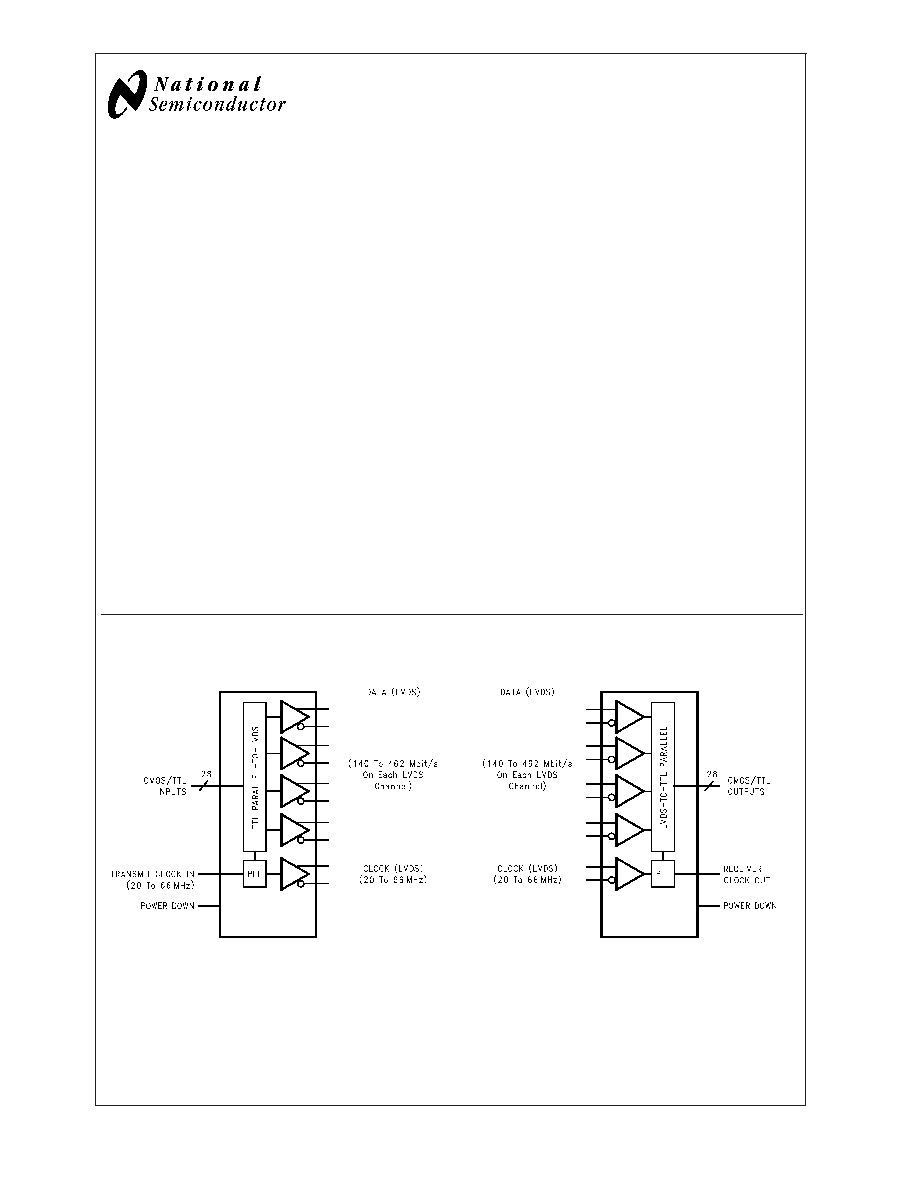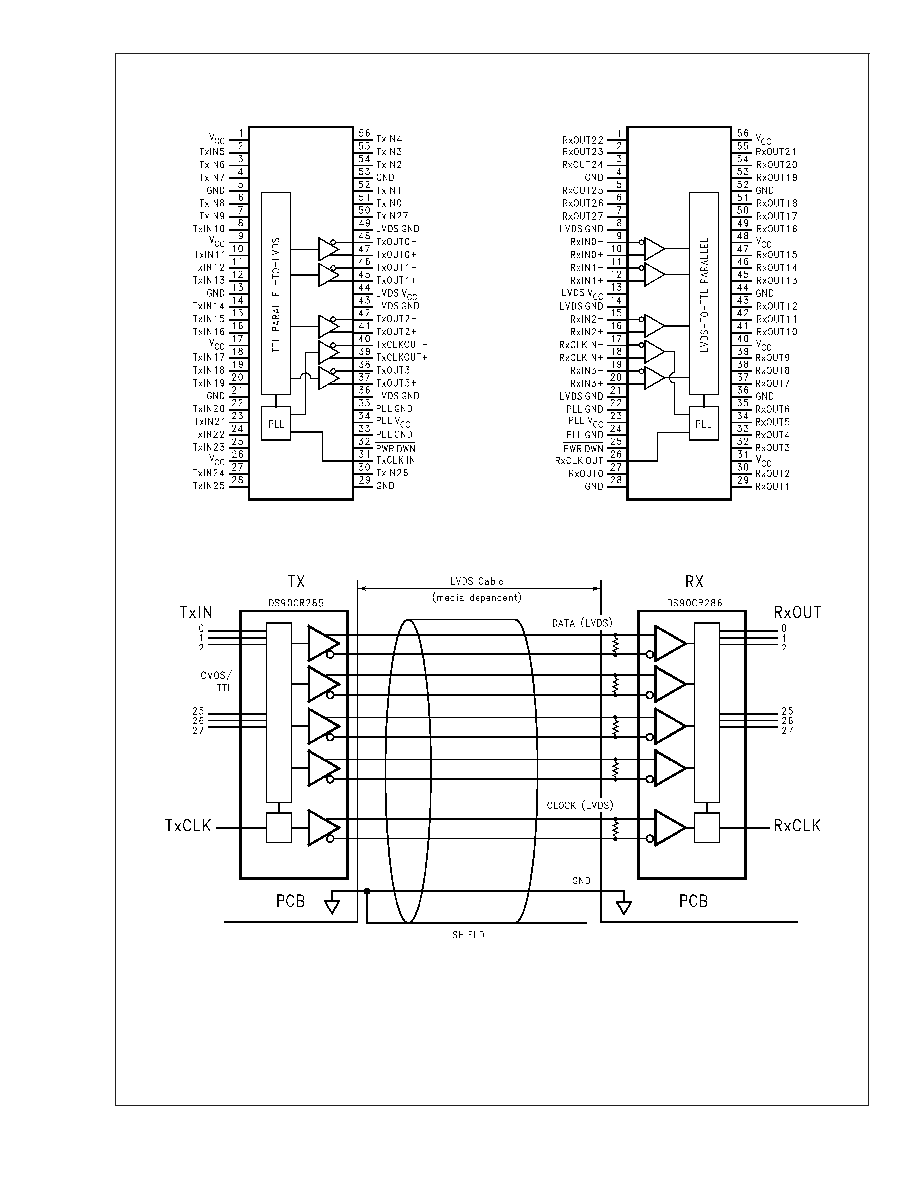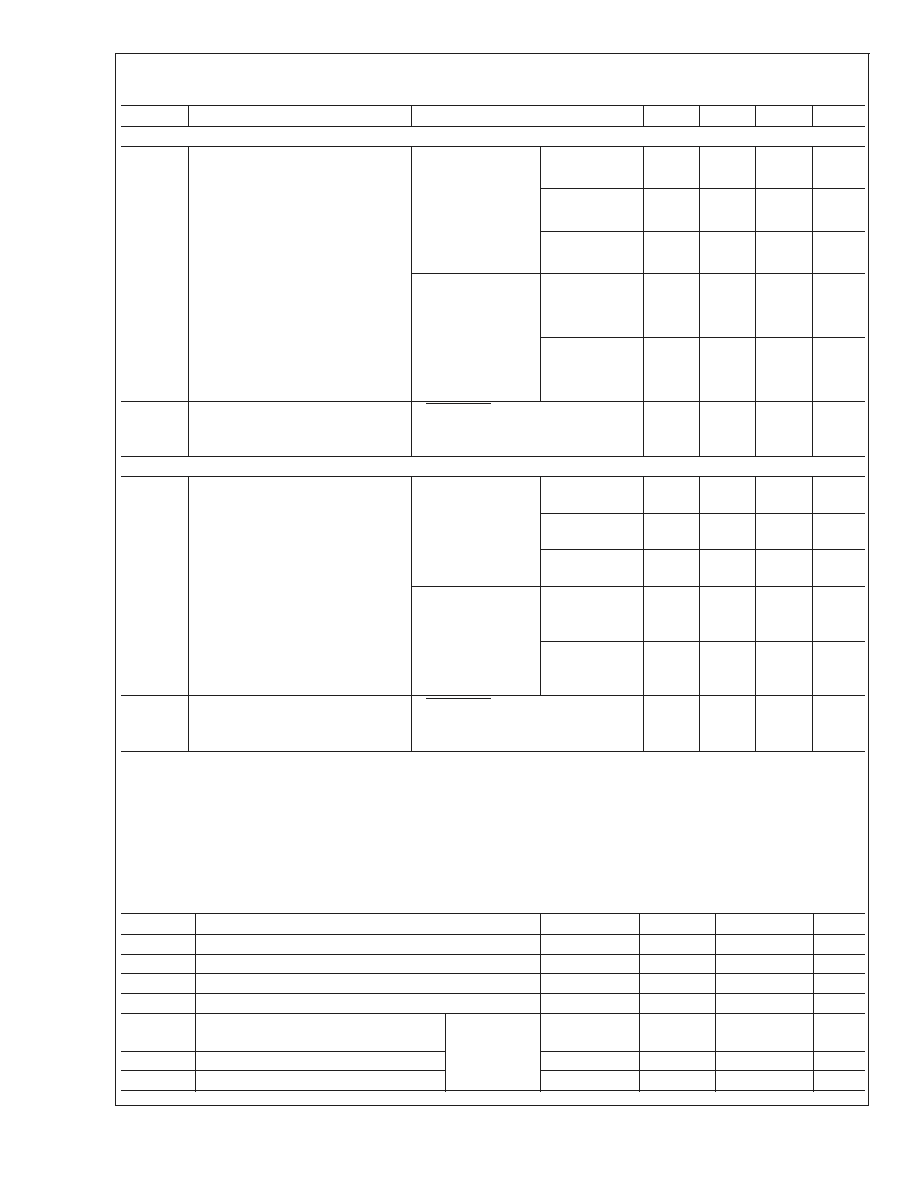Äîêóìåíòàöèÿ è îïèñàíèÿ www.docs.chipfind.ru

DS90CR285/DS90CR286
+3.3V Rising Edge Data Strobe LVDS 28-Bit Channel
Link-66 MHz
General Description
The DS90CR285 transmitter converts 28 bits of LVCMOS/
LVTTL data into four LVDS (Low Voltage Differential Signal-
ing) data streams. A phase-locked transmit clock is transmit-
ted in parallel with the data streams over a fifth LVDS link.
Every cycle of the transmit clock 28 bits of input data are
sampled and transmitted. The DS90CR286 receiver con-
verts the LVDS data streams back into 28 bits of LVCMOS/
LVTTL data. At a transmit clock frequency of 66 MHz, 28 bits
of TTL data are transmitted at a rate of 462 Mbps per LVDS
data channel. Using a 66 MHz clock, the data throughput is
1.848 Gbit/s (231 Mbytes/s).
The multiplexing of the data lines provides a substantial
cable reduction. Long distance parallel single-ended buses
typically require a ground wire per active signal (and have
very limited noise rejection capability). Thus, for a 28-bit wide
data and one clock, up to 58 conductors are required. With
the Channel Link chipset as few as 11 conductors (4 data
pairs, 1 clock pair and a minimum of one ground) are
needed. This provides a 80% reduction in required cable
width, which provides a system cost savings, reduces con-
nector physical size and cost, and reduces shielding require-
ments due to the cables' smaller form factor.
The 28 LVCMOS/LVTTL inputs can support a variety of
signal combinations. For example, seven 4-bit nibbles or
three 9-bit (byte + parity) and 1 control.
Features
n
Single +3.3V supply
n
Chipset (Tx + Rx) power consumption
<
250 mW (typ)
n
Power-down mode (
<
0.5 mW total)
n
Up to 231 Megabytes/sec bandwidth
n
Up to 1.848 Gbps data throughput
n
Narrow bus reduces cable size
n
290 mV swing LVDS devices for low EMI
n
+1V common mode range (around +1.2V)
n
PLL requires no external components
n
Both devices are offered in a Low profile 56-lead
TSSOP package
n
Rising edge data strobe
n
Compatible with TIA/EIA-644 LVDS standard
n
ESD Rating
>
7 kV
n
Operating Temperature: -40°C to +85°C
Block Diagrams
DS90CR285
DS90CR286
01291001
Order Number DS90CR285MTD
See NS Package Number MTD56
01291027
Order Number DS90CR286MTD
See NS Package Number MTD56
TRI-STATE
®
is a registered trademark of National Semiconductor Corporation.
July 2004
DS90CR285/DS90CR286
+3.3V
Rising
Edge
Data
Strobe
L
VDS
28-Bit
Channel
Link-66
MHz
© 2004 National Semiconductor Corporation
DS012910
www.national.com

Pin Diagrams for TSSOP Packages
DS90CR285
DS90CR286
01291021
01291022
Typical Application
01291023
DS90CR285/DS90CR286
www.national.com
2

Absolute Maximum Ratings
(Note 1)
If Military/Aerospace specified devices are required,
please contact the National Semiconductor Sales Office/
Distributors for availability and specifications.
Supply Voltage (V
CC
)
-0.3V to +4V
CMOS/TTL Input Voltage
-0.3V to (V
CC
+ 0.3V)
CMOS/TTL Output Voltage
-0.3V to (V
CC
+ 0.3V)
LVDS Receiver Input
Voltage
-0.3V to (V
CC
+ 0.3V)
LVDS Driver Output
Voltage
-0.3V to (V
CC
+ 0.3V)
LVDS Output Short Circuit
Duration
Continuous
Junction Temperature
+150°C
Storage Temperature
-65°C to +150°C
Lead Temperature
(Soldering, 4 sec.)
+260°C
Solder Reflow Temperature
Maximum Package Power Dissipation
@
+25°C
DS90CR285MTD
1.63 W
DS90CR286MTD
1.61 W
Package Derating:
DS90CR285MTD
12.5 mW/°C above +25°C
DS90CR286MTD
12.4 mW/°C above +25°C
ESD Rating
(HBM, 1.5 k
, 100 pF)
>
7 kV
Recommended Operating
Conditions
Min
Nom
Max
Units
Supply Voltage (V
CC
)
3.0
3.3
3.6
V
Operating Free Air
Temperature (T
A
)
-40
+25
+85
°C
Receiver Input Range
0
2.4
V
Supply Noise Voltage (V
CC
)
100 mV
PP
Electrical Characteristics
Over recommended operating supply and temperature ranges unless otherwise specified
Symbol
Parameter
Conditions
Min
Typ
Max
Units
LVCMOS/LVTTL DC SPECIFICATIONS
V
IH
High Level Input Voltage
2.0
V
CC
V
V
IL
Low Level Input Voltage
GND
0.8
V
V
OH
High Level Output Voltage
I
OH
= -0.4 mA
2.7
3.3
V
V
OL
Low Level Output Voltage
I
OL
= 2 mA
0.06
0.3
V
V
CL
Input Clamp Voltage
I
CL
= -18 mA
-0.79
-1.5
V
I
IN
Input Current
V
IN
= V
CC
, GND, 2.5V or 0.4V
±
5.1
±
10
µA
I
OS
Output Short Circuit Current
V
OUT
= 0V
-60
-120
mA
LVDS DRIVER DC SPECIFICATIONS
V
OD
Differential Output Voltage
R
L
= 100
250
290
450
mV
V
OD
Change in V
OD
between
Complimentary Output States
35
mV
V
OS
Offset Voltage (Note 4)
1.125
1.25
1.375
V
V
OS
Change in V
OS
between
Complimentary Output States
35
mV
I
OS
Output Short Circuit Current
V
OUT
= 0V, R
L
= 100
-3.5
-5
mA
I
OZ
Output TRI-STATE
®
Current
PWR DWN = 0V,
±
1
±
10
µA
V
OUT
= 0V or V
CC
LVDS RECEIVER DC SPECIFICATIONS
V
TH
Differential Input High Threshold
V
CM
= +1.2V
+100
mV
V
TL
Differential Input Low Threshold
-100
mV
I
IN
Input Current
V
IN
= +2.4V, V
CC
= 3.6V
±
10
µA
V
IN
= 0V, V
CC
= 3.6V
±
10
µA
DS90CR285/DS90CR286
www.national.com
3

Electrical Characteristics
(Continued)
Over recommended operating supply and temperature ranges unless otherwise specified
Symbol
Parameter
Conditions
Min
Typ
Max
Units
TRANSMITTER SUPPLY CURRENT
I
CCTW
Transmitter Supply Current Worst
Case (with Loads)
R
L
= 100
,
C
L
= 5 pF,
Worst Case
Pattern
(Figures 1, 2)
, T
A
= -10°C to
+70°C
f = 32.5 MHz
31
45
mA
f = 37.5 MHz
32
50
mA
f = 66 MHz
37
55
mA
R
L
= 100
,
C
L
= 5 pF,
Worst Case
Pattern
(Figures 1, 2)
, T
A
= -40°C to
+85°C
f = 40 MHz
38
51
mA
f = 66 MHz
42
55
mA
I
CCTZ
Transmitter Supply Current Power
Down
PWR DWN = Low
Driver Outputs in TRI-STATE
under Powerdown Mode
10
55
µA
RECEIVER SUPPLY CURRENT
I
CCRW
Receiver Supply Current Worst
Case
C
L
= 8 pF,
Worst Case
Pattern
(Figures 1, 3)
, T
A
= -10°C to
+70°C
f = 32.5 MHz
49
65
mA
f = 37.5 MHz
53
70
mA
f = 66 MHz
78
105
mA
C
L
= 8 pF,
Worst Case
Pattern
(Figures 1, 3)
, T
A
= -40°C to
+85°C
f = 40 MHz
55
82
mA
f = 66 MHz
78
105
mA
I
CCRZ
Receiver Supply Current Power
Down
PWR DWN = Low
Receiver Outputs Stay Low during
Powerdown Mode
10
55
µA
Note 1: "Absolute Maximum Ratings" are those values beyond which the safety of the device cannot be guaranteed. They are not meant to imply that the device
should be operated at these limits. The tables of "Electrical Characteristics" specify conditions for device operation.
Note 2: Typical values are given for V
CC
= 3.3V and T
A
= +25°C.
Note 3: Current into device pins is defined as positive. Current out of device pins is defined as negative. Voltages are referenced to ground unless otherwise
specified (except V
OD
and
V
OD
).
Note 4: V
OS
previously referred as V
CM
.
Transmitter Switching Characteristics
Over recommended operating supply and -40°C to +85°C ranges unless otherwise specified
Symbol
Parameter
Min
Typ
Max
Units
LLHT
LVDS Low-to-High Transition Time (Figure 2)
0.5
1.5
ns
LHLT
LVDS High-to-Low Transition Time (Figure 2)
0.5
1.5
ns
TCIT
TxCLK IN Transition Time (Figure 4)
5
ns
TCCS
TxOUT Channel-to-Channel Skew (Figure 5)
250
ps
TPPos0
Transmitter Output Pulse Position for Bit0
(Note 7) (Figure 16)
f = 40 MHz
-0.4
0
0.4
ns
TPPos1
Transmitter Output Pulse Position for Bit1
3.1
3.3
4.0
ns
TPPos2
Transmitter Output Pulse Position for Bit2
6.5
6.8
7.6
ns
DS90CR285/DS90CR286
www.national.com
4

Transmitter Switching Characteristics
(Continued)
Over recommended operating supply and -40°C to +85°C ranges unless otherwise specified
Symbol
Parameter
Min
Typ
Max
Units
TPPos3
Transmitter Output Pulse Position for Bit3
10.2
10.4
11.0
ns
TPPos4
Transmitter Output Pulse Position for Bit4
13.7
13.9
14.6
ns
TPPos5
Transmitter Output Pulse Position for Bit5
17.3
17.6
18.2
ns
TPPos6
Transmitter Output Pulse Position for Bit6
21.0
21.2
21.8
ns
TPPos0
Transmitter Output Pulse Position for Bit0
(Note 6) (Figure 16)
f = 66 MHz
-0.4
0
0.3
ns
TPPos1
Transmitter Output Pulse Position for Bit1
1.8
2.2
2.5
ns
TPPos2
Transmitter Output Pulse Position for Bit2
4.0
4.4
4.7
ns
TPPos3
Transmitter Output Pulse Position for Bit3
6.2
6.6
6.9
ns
TPPos4
Transmitter Output Pulse Position for Bit4
8.4
8.8
9.1
ns
TPPos5
Transmitter Output Pulse Position for Bit5
10.6
11.0
11.3
ns
TPPos6
Transmitter Output Pulse Position for Bit6
12.8
13.2
13.5
ns
TCIP
TxCLK IN Period (Figure 6 )
15
T
50
ns
TCIH
TxCLK IN High Time (Figure 6)
0.35T
0.5T
0.65T
ns
TCIL
TxCLK IN Low Time (Figure 6)
0.35T
0.5T
0.65T
ns
TSTC
TxIN Setup to TxCLK IN (Figure 6)
2.5
ns
THTC
TxIN Hold to TxCLK IN (Figure 6)
0
ns
TCCD
TxCLK IN to TxCLK OUT Delay
@
25°C,V
CC
=3.3V (Figure
8)
3
3.7
5.5
ns
TPLLS
Transmitter Phase Lock Loop Set (Figure 10)
10
ms
TPDD
Transmitter Powerdown Delay (Figure 14)
100
ns
Receiver Switching Characteristics
Over recommended operating supply and -40°C to +85°C ranges unless otherwise specified
Symbol
Parameter
Min
Typ
Max
Units
CLHT
CMOS/TTL Low-to-High Transition Time (Figure 3)
2.2
5.0
ns
CHLT
CMOS/TTL High-to-Low Transition Time (Figure 3)
2.2
5.0
ns
RSPos0
Receiver Input Strobe Position for Bit 0 (Note 7)(Figure 17)
f = 40 MHz
1.0
1.4
2.15
ns
RSPos1
Receiver Input Strobe Position for Bit 1
4.5
5.0
5.8
ns
RSPos2
Receiver Input Strobe Position for Bit 2
8.1
8.5
9.15
ns
RSPos3
Receiver Input Strobe Position for Bit 3
11.6
11.9
12.6
ns
RSPos4
Receiver Input Strobe Position for Bit 4
15.1
15.6
16.3
ns
RSPos5
Receiver Input Strobe Position for Bit 5
18.8
19.2
19.9
ns
RSPos6
Receiver Input Strobe Position for Bit 6
22.5
22.9
23.6
ns
RSPos0
Receiver Input Strobe Position for Bit 0 (Note 6)(Figure 17)
f = 66 MHz
0.7
1.1
1.4
ns
RSPos1
Receiver Input Strobe Position for Bit 1
2.9
3.3
3.6
ns
RSPos2
Receiver Input Strobe Position for Bit 2
5.1
5.5
5.8
ns
RSPos3
Receiver Input Strobe Position for Bit 3
7.3
7.7
8.0
ns
RSPos4
Receiver Input Strobe Position for Bit 4
9.5
9.9
10.2
ns
RSPos5
Receiver Input Strobe Position for Bit 5
11.7
12.1
12.4
ns
RSPos6
Receiver Input Strobe Position for Bit 6
13.9
14.3
14.6
ns
RSKM
RxIN Skew Margin (Note 5) (Figure 18)
f = 40 MHz
490
ps
f = 66 MHz
400
ps
RCOP
RxCLK OUT Period (Figure 7)
15
T
50
ns
RCOH
RxCLK OUT High Time (Figure 7)
f = 40 MHz
6.0
10.0
ns
f = 66 MHz
4.0
6.1
ns
RCOL
RxCLK OUT Low Time (Figure 7)
f = 40 MHz
10.0
13.0
ns
f = 66 MHz
6.0
7.8
ns
DS90CR285/DS90CR286
www.national.com
5
Document Outline




